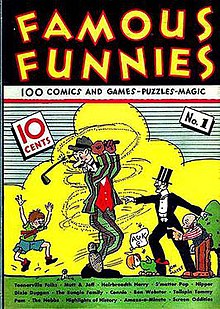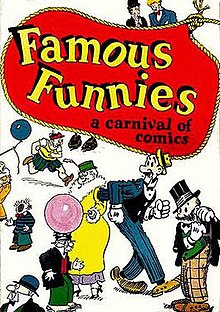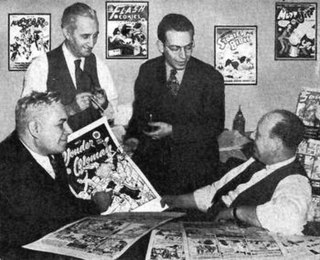
Maxwell Charles Gaines was an American publisher and a pioneering figure in the creation of the modern comic book.

An American comic book is a thin periodical originating in the United States, on average 32 pages, containing comics. While the form originated in 1933, American comic books first gained popularity after the 1938 publication of Action Comics, which included the debut of the superhero Superman. This was followed by a superhero boom that lasted until the end of World War II. After the war, while superheroes were marginalized, the comic book industry rapidly expanded and genres such as horror, crime, science fiction and romance became popular. The 1950s saw a gradual decline, due to a shift away from print media in the wake of television and the impact of the Comics Code Authority. The late 1950s and the 1960s saw a superhero revival and superheroes remained the dominant character archetype throughout the late 20th century into the 21st century.
Tailspin Tommy was an aviation-adventure comic strip about a youthful pilot, "Tailspin" Tommy Tomkins. Originally illustrated by Hal Forrest and initially distributed by John Neville Wheeler's Bell Syndicate and then by United Feature Syndicate, the strip had a 14-year run from May 21, 1928 to March 15, 1942.
See also: 1920s in comics, other events of the 1930s, 1940s in comics and the list of years in comics
Notable events of 1939 in comics.
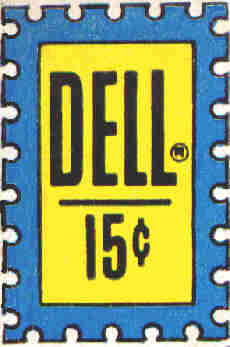
Dell Comics was the comic book publishing arm of Dell Publishing, which got its start in pulp magazines. It published comics from 1929 to 1974. At its peak, it was the most prominent and successful American company in the medium. In 1953 Dell claimed to be the world's largest comics publisher, selling 26 million copies each month.
Notable events of 1938 in comics.
Notable events of 1937 in comics.
Notable events of 1936 in comics.

The Funnies was the name of two American publications from Dell Publishing, the first of these a seminal 1920s precursor of comic books, and the second a standard 1930s comic book.

Major Malcolm Wheeler-Nicholson was an American pulp magazine writer and entrepreneur who pioneered the American comic book, publishing the first such periodical consisting solely of original material rather than reprints of newspaper comic strips. Historian and author David Hajdu credits Wheeler-Nicholson as "the link between the pulps and what we know of as comics today." And launching the magazine comics company National Allied Publications in 1934, which would evolve to become DC Comics. He was a 2008 Judges' Choice inductee into the Will Eisner Comic Book Hall of Fame.

Mickey Finn was an American comic strip created by cartoonist Lank Leonard, which was syndicated to newspapers from April 6, 1936 to September 10, 1977. The successful lighthearted strip struck a balance between comedy and drama. It was adapted to a 400-page Little Big Book and was reprinted in several comic book series throughout the 1930s and 1940s.
The Eastern Color Printing Company was a company that published comic books, beginning in 1933. At first, it was only newspaper comic strip reprints, but later on, original material was published. Eastern Color Printing was incorporated in 1928, and soon became successful by printing color newspaper sections for several New England and New York papers. Eastern is most notable for its production of Funnies on Parade and Famous Funnies, two publications that gave birth to the American comic book industry.

Dan Dunn is a fictional detective created by Norman W. Marsh. He first appeared in Detective Dan: Secret Operative No. 48, a proto-comic book from 1933, produced by Humor Publishing. He subsequently appeared in newspaper comic strips from 1933 to 1943.

Funnies on Parade is an American giveaway publication of 1933 that was a precursor of comic books. The eight-page publication featured reprints of such popular syndicated comic strips as The Bungle Family, Joe Palooka, Keeping Up with the Joneses, Mutt and Jeff, Reg'lar Fellers, and Somebody's Stenog. Creators included F. O. Alexander, Gene Byrnes, Al Capp, Clare Victor Dwiggins, A. E. Hayward, C. M. Payne, Al Smith, and Harry J. Tuthill.
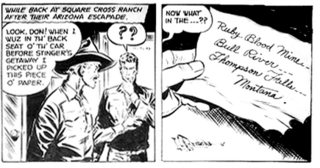
Don Winslow of the Navy was an American comic strip created by Frank Victor Martinek and distributed mostly by the Bell Syndicate from 1934 to 1955. The title character was a spy-chasing lieutenant commander in Naval intelligence. The comic strip led to a radio adventure serial that began in 1937, as well as film serials that began in 1942. Original comic book stories also appeared in Fawcett Comics titles starting in 1943.
The Bell Syndicate, launched in 1916 by editor-publisher John Neville Wheeler, was an American syndicate that distributed columns, fiction, feature articles and comic strips to newspapers for decades. It was located in New York City at 247 West 43rd Street and later at 229 West 43rd Street. It also reprinted comic strips in book form.
The Public Ledger Syndicate was a syndication company operated by the Philadelphia Public Ledger that was in business from 1915 to circa 1950. The Ledger Syndicate distributed comic strips, panels, and columns to the United States and the United Kingdom, Ireland, Canada, Sweden, New Zealand, and Australia. The syndicate also distributed material from the Curtis Publishing Company's other publications, including The Saturday Evening Post, Ladies' Home Journal, and The Country Gentleman.
Associated Newspapers, Inc. was a print syndication service of columns and comic strips that was in operation from 1912 to c. 1966. The syndicate was originally a cooperative of four newspapers: The New York Globe, the Chicago Daily News, The Boston Globe, and the Philadelphia Bulletin. Associated Newspapers was led by Henry Herbert McClure (1874-1938), a cousin of S. S. McClure, founder of the McClure Syndicate, the first American newspaper syndicate. In 1930, Associated Newspapers was acquired by and became a subsidiary of the Bell Syndicate. The syndicate's most successful, long-running strip was Gladys Parker's Mopsy.
Uncle Art's Funland is a long-running syndicated weekly puzzle and entertainment feature originated by Art Nugent (1891–1975). Featuring jokes, riddles, and paper-and-pencil word games, math challenges, nonograms, connect-the-dots art, crossword puzzles and anagrams, Funland has appeared in newspapers and comic books since 1933, and has been syndicated regularly since 1950.
